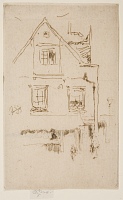Etchings Institutions search term: grolier club
Little Maunder's | ||
| Number: | 273 | |
| Date: | 1887 | |
| Medium: | etching | |
| Size: | 83 x 52 mm | |
| Signed: | butterfly at left | |
| Inscribed: | no | |
| Set/Publication: | no | |
| No. of States: | 1 | |
| Known impressions: | 7 | |
| Catalogues: | K.279; M.274 | |
| Impressions taken from this plate (7) | ||
KEYWORD
TITLE
'Little Chelsea Fish shop' (1887, Whistler). 2
'Maunders' (1887/1888, Whistler). 3
'Little Maunders' (1889, Whistler). 4
'Little Maunder’s' (1902, Edward Guthrie Kennedy (1849-1932)). 5
'Gable - Little Maunders' (1903, Wunderlich's) 6
'Little Maunder's Fish Shop. Chelsea' (1903/1935, possibly Rosalind Birnie Philip (1873-1958)). 7
'Little Maunder's' (1909, Howard Mansfield (1849-1938)). 8
Thus Whistler called it by three different titles, but since the third of these was picked up by later cataloguers, as 'Little Maunder’s', this has become the preferred title.
2: Whistler to Dowdeswell's, 27 July 1887, GUW #08677.
3: List, [August 1887/1888], GUW #13233.
4: List, 18 July 1889, GUW #13235.
5: Kennedy 1902 (cat. no. 299).
6: Wunderlich's stock no. 'a 38268'.
7: Envelope containing copper plate, Hunterian Art Gallery.
8: Mansfield 1909 (cat. no. 274).
DESCRIPTION
SITE
The shop was popular with local artists as representative of a picturesque but fast disappearing aspect of the old village. There was a watercolour by Alice Boyd dating from 1874; a drawing by Whistler's friend Percy Thomas (1846-1922); and another watercolour published (many years later, in 1905) by Philip Norman in London Vanished and Vanishing. 9 An etching by Thomas, Old Chelsea - Cheyne Walk, published in 1889, shows the fish-shop in the middle of a row of shops. 10 Another etching, by William Burgess, included in Lionel Johnson & Richard le Gallienne's Bits of Old Chelsea of 1894, shows, in rather fussy detail, the façade, the shop interior and shop sign, which, as Robins points out, were simplified in Whistler's images. 11
An etching by Whistler's friend and 'follower' Théodore Roussel (1847-1926), reproduced below, shows the ground and first floor of the same shop, with a gas lamp standing in front of the door, instead of - as portrayed by Whistler - in front of the building next door. 12

T. Roussel, The Little Fish Shop, Chelsea Embankment, 1888-1889, etching,
© Trustees of the British Museum.
9: Dave Walker, 'The famous fish shop', The Library Time Machine, http://rbkclocalstudies. wordpress.com/ (accessed 2012).
10: W. Holmes May, ed., English Etchings, VIII, 1889, p. 26.
11: Robins 2007 , p. 128.
12: Hausberg 1991 , cat. no. 25.

